Immigration raids: how direct action got UK’s ICE squads on the run
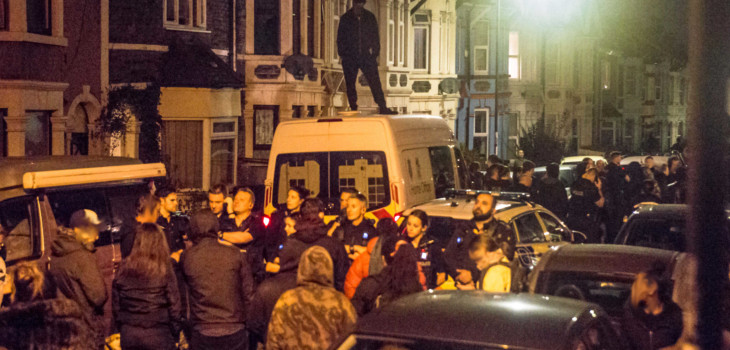
Immigration raids on people’s workplaces are one of the UK government’s main terror tactics against migrants. But in the last few years, they have also become one of the main battlegrounds where people are fighting back against the “hostile environment”.
Corporate Watch has investigated how the raids are carried out, including the key role played by employers and other informants. Chapter Six of our book on the UK Border Regime presents a detailed overview. Now a new report from the Independent Chief Inspector of Borders and Immigration (ICIBI) gives a further glimpse of how the system works.
In response to recent criticism of the raids, the Home Office has blustered that it is less reliant on obvious racial targeting, and that its actions have become more “intelligence led”. But the ICIBI report shows that little has actually changed. The standard tactic remains crashing into Indian or Chinese restaurants and rounding up as many people as possible.
What has changed, though, is the level of resistance. The most interesting part of the Inspector’s report details how, since 2015, the squads have met increasing “incidents of disruption”. The report discusses organising by one group involved in this, the Anti Raids Network. But this resistance goes beyond any one group or network. It has spread informally and virally. And it has had a very real impact, denting raid squads’ confidence and forcing them onto the retreat.

Raids snapshot 2018: much the same, officers even more miserable
We’ll look at those points more closely in a moment. First, though, a few basic updates on the raids themselves.
Officially, there are just under 7,000 workplace raids a year. That’s in line with previous figures we looked at in our book The UK Border Regime. According to the Inspector’s report, Immigration Compliance and Enforcement (ICE) squads carried out 23,413 “illegal working” “deployments” in just under three and a half years, from April 2015 to August 2018.i
The raiders “encountered 83,855 individuals and made 14,762 arrests” (“encountered” presumably means stopping and questioning). So on an average raid, they question about four people. But most are let go, and they don’t make arrests on every raid.
Most raids are still supposedly based on tip-offs from “members of the public”. Over half are still on “restaurants and fast food outlets, and concentrated on a few nationalities”. Nearly two thirds, 63%, of all people arrested were from just four nationalities: Bangladeshis, Indians, Pakistanis, and Chinese.
This is pretty much the same picture as in earlier reports – see here for a more in depth look. In the last report, in 2015, the Inspector noted managers were claiming to be moving away from hitting “easy targets” in high street takeaways, instead developing new kinds of intelligence and operations. In the 2015 report, 85% of all arrests were from the four nationalities listed above, so you might say there has been some “progress”. But not a lot.
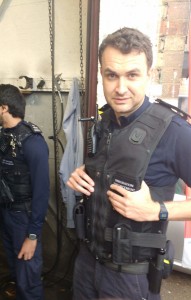
Low morale
Something else that hasn’t changed: morale is seriously low. The report says that, within the Home Office itself, different departments barely communicate. For example, ICE officers and the Intelligence teams that are supposed to guide them “were critical of one another”. The planned “single intelligence platform” does not seem to be working.
The Windrush scandal, and the Home Office’s response to it, has lowered spirits even further: “the declared move away from removal targets had left some unsure about what ‘success’ now looked like, and this was affecting morale.” Officers felt “other government departments” were less keen to collaborate with them and “less willing to be associated with Immigration Enforcement”.
One other big complaint was about the difficulty of recruitment. “As at September 2018, the budgeted headcount for ICE teams nationally was 1,208 full-time equivalents (FTEs), but there were 121 vacancies.” This was the case across all regions. As one manager said: “resources are a massive problem. We are 12 people down and this impacts on our capability to task and deploy.”
For example, according to the report:
“an ICE team of 7 officers might be tasked with 2 or 3 deployments in a day. If an individual was arrested during the first deployment and required escorting to a police station it would take 2 officers away. This would mean that the team would no longer have enough officers to complete the remaining deployments.”
In turn, that creates extra stress on the remaining officers, which means even more “staff going off with lots of sick.”
The other big hit on morale came from “a rise in attempts to disrupt ICE deployments through acts of violence against IE property or ICE officers, threatening behaviour, verbal abuse and protests, some of which appeared to have been coordinated using social media.”
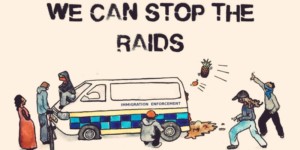
Rising disruption
In our book The UK Border Regime, we collated a brief timeline of growing actions to interfere with raids. In February 2013, the newly formed Anti Raids Network held a demonstration on Old Kent Road, South London, where local Latin American and African residents were being hit by a wave of raids. The same evening, people patrolled the street looking for raid vans, and intervened when an ICE team was spotted attacking a Nigerian restaurant.
But things really hotted up in the summer of 2015. In May, a video went viral on social media of a big crowd chasing away a raid van from the high street in Peckham, South London. A few weeks later, in June, over 100 people tried to rescue a man arrested in a raid just a mile or two down the road at East Street market. The ICE team called in riot police support, which unsurprisingly provoked a small riot.
In July, resistance spread across the river to Shadwell, East London, where locals chased off a party of raid vans attacking the Bangladeshi traders there. This was covered by the national media. The Daily Mail blamed a “muslim gang” who “slashed tyres” and “pelted [immigration officers] with eggs”.
In the months after that, “anti raids activities” continued and spread in London. These involved everything from local groups running street stalls and putting up posters, to people attacking the highly visible raid vans. Deptford high street, in the borough of Lewisham, became one focal point. Traders organised a local alert network against regular raids, while vans were chased off or sabotaged.
According to the Inspector’s report:
“some reactions to ICE teams appeared spontaneous and relatively petty. For example, while inspectors were observing a deployment in South London, youths threw a firework at the ICE van and shouted abuse before running off. Some passers-by also made derogatory comments. However, some were more serious. Inspectors were told that during a recent deployment in Lewisham (South East London), the ICE team was subjected to a coordinated attack and a concrete slab was thrown at an IE vehicle.”
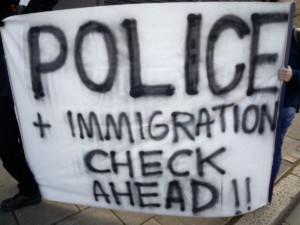
How the raiders reacted
The report gives us some insight into how Immigration Enforcement reacted to all this. They called in the National Police Chiefs’ Council (NPCC) to conduct an “Anti-Raids Intelligence Assessment”, produced in April 2016. This seems to have both profiled the Anti Raids Network itself, and also looked more widely at the spreading phenomenon of raid resistance.
Probably on the recommendation of this report, in the same month ICE teams started filling out “Activist Intel Reports” whenever a significant “incident” occurred. They wrote reports on 16 “disruptions” in 2016-17; 27 in 2017-18; and 21 in just the first six months from April 2018.
Another step was to start running trainings for ICE teams, mainly in London, in:
“how to manage members of the public who were intending to disrupt enforcement activity, how to recognise potential public order situations, to pre-empt them where possible, and to conduct a tactical handover to the relevant specialist police team where necessary.”
However, ICE officers only get a basic 25 days training. A one-off session on “public order” certainly doesn’t bring them up to anything like the level of understanding of a trained police officer. This is an important factor in understanding the impact anti-raids resistance has actually had.
According to the Anti Raids Network itself, from 2016 on there was a notable shift in approach whenever ICE teams were confronted by even very minimal opposition. For example, the Network documented various occasions where just a couple of people watching and filming a raid squad, or shouting at them to leave, caused the team to do just that. (E.g., here, and here.) The squad seemed particularly worried if they thought news of their presence was being spread on social media.
The key point is that ICE teams follow certain basic instructions: if you encounter “protest”, call back to base for a commander’s advice. The manager then has to decide from a range of options: authorise the operation continuing; or call for police back-up; or call it off. But managers may not want to risk a situation escalating, and police are not always on hand or willing to support. Hence raid managers will often be “risk averse” and call back the squad. After all, there’s always another Indian takeaway to hit a few miles away. (Again, we discuss raid procedures in more depth in Chapter 6 of the book, and also here.)

Image: raid resisted in Chinatown, 2018
Two conclusions
The ICIBI report certainly doesn’t give the whole picture, but it supplements what we already know from other sources. It highlights two important points about anti-raids resistance and its impacts.
First, “direct action gets the goods”.** The rise in “disruptions” noticeably made ICE teams back-pedal, to the point of some giving up raids as soon as they encountered minimal opposition.
Note that, while big media attention on the Windrush scandal has also hit ICE confidence, the shift started before that story broke. It wasn’t caused by media attention, but by local acts of confrontation, most of which were never reported by the press. A few “youths throwing a firework” here, a smashed windscreen there, up to the near-riots of Summer 2015. As well as these acts themselves, there was the chatter and buzz about them on social media, or on posters pasted up on the walls of neighbourhoods targeted by ICE squads.
The anti-raids case is a reminder of the power of direct action, spread at a grassroots level. Much campaigning against the “hostile environment” has been based around trying to get stories in major media outlets. But this is not the only form of resistance. Direct action can also be more empowering for those involved – many people are able to participate, not just a few experts or spokespeople.
The second point is one noted by the Police Chiefs’ (NPCC) “intellience assessment” referred to in the report. One of their findings is:
“the majority of incidents were not coordinated by a group or activist, but involved members of the local community, unaffiliated to any groups.”
The Anti Raids Network certainly played a part. It wasn’t just a coincidence that “incidents of disruption” jumped soon after this network got active in certain areas of South and East London. But that doesn’t mean people active in that network were involved in more than a handful of “incidents”.
Much of the resistance to immigration raids has spread informally, without any coordinating organisation. It spread “virally”, as thousands of people passed on stories, made or read posters, shared youtube videos or twitter alerts. And then acted in their own ways.
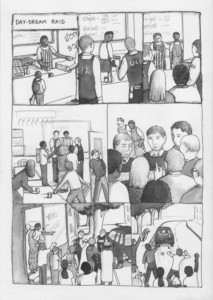
Top image: raid resisted in Bristol, 2018
i In fact, that seems quite a low figure. It would mean an average of 571 raids a month across the whole UK – so each of the 18 ICE squads raiding just about one business a day. But then we don’t know just what they include in the statistics. Quite likely, there are many more “informal” raids without the proper evidence trail, which just get left off the books.
** By “direct action” we mean: people intervening directly to achieve a result for themselves, such as stopping a raid, rather than calling on external authorities, such as politicians or the media, to act for them.
“Every person who ever had a plan to do anything, and went and did it, or who laid his plan before others, and won their co-operation to do it with him, without going to external authorities to please do the thing for them, was a direct actionist. All co-operative experiments are essentially direct action. Every person who ever in his life had a difference with anyone to settle, and went straight to the other persons involved to settle it, either by a peaceable plan or otherwise, was a direct actionist.” (Voltairine de Cleyre “Direct Action”, 1912.)
